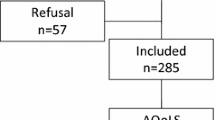Abstract
The current study assessed whether perceived quality of life differed between alcoholics and non-alcoholics. Patients attending an urban-based hospital were screened for alcoholism using the CAGE questionnaire. Patients were recruited from an out-patient clinic setting as well as from an in-patient substance abuse unit. Quality of life scores were based on Chubon's (1987) Life Situation Survey. Results indicated that alcoholics experience a lower quality of life than their non-alcoholic counterparts regardless of setting; however, all patients reported experiencing poor life quality. The impact of alcoholism treatment programmes on patients already experiencing low quality of life is questioned.
Similar content being viewed by others
References
World Services Inc. Alcoholics Anonymous: A story of how many thousands of men and women have recovered from alcoholism. New York: 1976.
ChubonRA. Developing a quality-of-life rating scale for use in health care evaluation. Eval Health Prof 1987; 10: 186–200.
EmrickCD. Alcoholics Anonymous: Affiliation processes and effectiveness as treatment. Alc Clin Exp Res 1987; 11: 416–423.
McLellanAT, LuborskyL, WoodyGE, O'BrienCP, KronR. Are the ‘addiction-related’ problems of substance abusers really related? J Nerv Ment Dis 1981; 169: 232–239.
AmodeoM, KurtzN, CutterHS. Abstinence, reasons for not drinking, and life satisfaction. Int J Addict 1992; 27: 707–716.
VaillantGE. The Natural History of Alcoholism. Massachusetts: Harvard University Press, 1983.
MetzgerDS, O'BrienCP. Substance abuse: The challenge of assessment. In: SpilkerB., ed. Quality of Life Assessments in Clinical Trials. New York: Raven Press, 1990: 237–246.
AkerlindI, HornquistJO, EltonM, BjurulfP. Overall functioning and criteria of progress in rehabilitation of alcohol abusers: longitudinal analyses of changes. Alc Clin Exp Res 1990; 14: 856–862.
HeatherN. Psychology and brief interventions. Br J Addict 1989; 84: 357–370.
SkinnerHA, HoltS. Early intervention for alcohol problems. J Roy Coll Gen Pract 1983; 33: 787–791.
EwingJA. Detecting alcoholism: The CAGE questionnaire. JAMA 1984; 252: 1905–1907.
MayfieldD, McLeodG, HallP. The CAGE questionnaire: validation of a new alcoholism screening instrument. Am J Psychiatry 1984; 131: 1121–1123.
BuchsbaumDG, BuchananRG, CentorRM, SchnollSH, LawtonMJ. Screening for alcohol abuse using CAGE scores and likelihood ratios. Ann Intern Med 1991; 15: 774–777.
ChubonRA. Development of a quality of life rating scale for use in health care evaluation. Eval Health Prof 1987; 10: 186–200.
HeinemannH, Smith-DijulioK. Care of the chronically ill person. In: EstesNJ, HeinemannH, eds. Alcoholism: Development, Consequences, and Interventions. St. Louis; CV Mosby Co, 1982; 283–293.
AkerlindI, HornquistJO, HanssonB. Loneliness correlates in advanced alcohol abusers. Scand J Soc Med 1987; 15: 175–183.
MoosRH, FennCB, BillingAG, MoosBS. Assessing life stressors and social resources: Applications to alcoholic patients. J Substance Abuse 1989; 1: 135–152.
IrwinPH. Quality of life assessment and drug abuse treatment program evaluation. Eval Prog Plan 1981; 4: 123–130.
SeemanM, SeemanAZ. Life strains, alienation, and drinking behavior. Alc Clin Exp Res 1992; 16: 199–205.
SpitzerWO. State of science 1986: Quality of life and functional status as target variables for research. J Chronic Dis 1987; 6: 465–471.
BergnerM, BobbittRA, PollardWE, MartinDP, GilsonBS. The sickness impact profile: Validation of a health status measure. Med Care 1976; 14: 57–67.
KaplanRM, BushJW, BerryCC. Health status: types of validity and the index of well-being. Health Serv Res 1976; 11: 478–507.
BrookRH, WareJE, Davies-AveryA. Overview of adult health status measure fielded in Rand's health insurance study. Med Care 1979; 17: 1–131.
WeissmanMM, BothwellS. Assessment of social adjustment by patient self-report. Arch Gen Psychiatry 1976; 33: 1111–1115.
DerogatisLR, LipmanRS, CoviL, RickelsK. Factorial invariance of symptom dimensions in anxious and depressed neuroses. Arch Gen Psychiatry 1972; 27: 659–665.
FriesJF, SpitzPW, KrainesRG, HolmanHR. Measurement of patient outcome in arthritis. Arthritis Rheum 1980; 23: 137–145.
CrumbaughJC, MaholicLT. An experimental study in existentialism: the psychometric approach to Frankl's noogenic neurosis. J Clin Psychol 1964; 20: 200–207.
MillerJF. Development of an instrument to measure hope. Nurs Res 1988; 37: 6–10.
NeugartenBL, HavinghurstRJ, TobinSS. The measurement of life satisfaction. J Gerentol 1961; 16: 134–143.
ChubonRA. Quality of life measurement of persons with back problems: some preliminary quality of life findings. J Appl Rehab Counsel 1985; 16: 31–34.
ChubonRA. Quality of life and persons with end stage renal disease. Dialysis Transplant 1986; 15: 450–452.
TrudelL, FabiaJ, BouchardJP. Quality of life of 50 carotid endarterectomy survivors: a long-term follow-up study. Arch Phys Med Rehab 1984; 65: 310–312.
StewartWW, ChubonRA, WeldonNL. Utilization of a quality-of-life indicators based assessment instrument in alcoholism treatment programs. Vocational Evaluation and Work Adjustment Bulletin 1989; 22: 31–34.
SpilkerB. Quality of Life Assessments in Clinical Trials. New York: Raven Press, 1990.
World Health Organization. Constitution of the World Health Organization. Geneva: WHO Basic Documents, 1948.
Author information
Authors and Affiliations
Additional information
Study supported by NIAAA-R01-AA08278
Rights and permissions
About this article
Cite this article
Welsh, J.A., Buchsbaum, D.G. & Kaplan, C.B. Quality of life of alcoholics and non-alcoholics: does excessive drinking make a difference in the urban setting?. Qual Life Res 2, 335–340 (1993). https://doi.org/10.1007/BF00449428
Received:
Accepted:
Issue Date:
DOI: https://doi.org/10.1007/BF00449428



